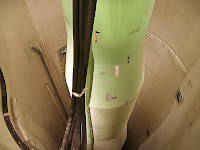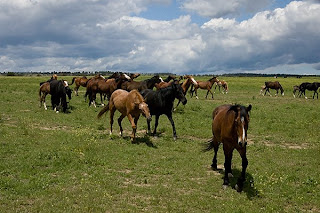 Just outside Ellsworth Air Force Base sits an old remodeled aircraft hanger that is now the site of the South Dakota Air and Space Museum. Air Force fighters, bombers, cargo planes and trainers take up all the extra lawn space on the outside of the museum, some with inactive bombs attached to their wings, some with painted ladies on their noses, and most with one or more flat tires, the planes held in place by blocks.
Just outside Ellsworth Air Force Base sits an old remodeled aircraft hanger that is now the site of the South Dakota Air and Space Museum. Air Force fighters, bombers, cargo planes and trainers take up all the extra lawn space on the outside of the museum, some with inactive bombs attached to their wings, some with painted ladies on their noses, and most with one or more flat tires, the planes held in place by blocks.
 One of the largest planes at the museum was the B52 Stratofortress. The plane on display was configured with the same weapons' load as those flown in Vietnam -- 12 bombs on each wing and 84 inside. The wingpan of 185 feet, requiring wheels at the wingtips to prevent them from scraping the runway when fully fueled, exceeds the plane's length of 156 feet, 7 inches. It could fly over 6000 miles before refueling, and reached a maximum speed of 636 miles per hour. To handle all this bulk and armament, a crew of only 6 people was required.
One of the largest planes at the museum was the B52 Stratofortress. The plane on display was configured with the same weapons' load as those flown in Vietnam -- 12 bombs on each wing and 84 inside. The wingpan of 185 feet, requiring wheels at the wingtips to prevent them from scraping the runway when fully fueled, exceeds the plane's length of 156 feet, 7 inches. It could fly over 6000 miles before refueling, and reached a maximum speed of 636 miles per hour. To handle all this bulk and armament, a crew of only 6 people was required.
The Air and Space Museum sits just outside the gates to Ellsworth Air Force Base, home to over 4000 service men and women and their families, and one of the emergency landing sites for the Space Shuttle. Security is tight -- we had to provide our driver's licenses for a "wants and warrants" check before we could board the small tour bus that would take us into the base (yes, everyone "passed"!).
The base is a small city, with every ammenity a family could need or want. We circled the base, our driver pointing out the nightclubs, athletic facilities, housing, and shopping areas.The most interesting stop, however, was the missile silo.
 A relic of the cold war, 150 missile silos, and 15 control centers once dotted this area of South Dakota. Each control center could launch 10 of the missiles, with backup procedures in place to transfer the ability to launch to another center if the need arose. The centers were always located miles away from the actual missiles. This picture shows the topside of the silo with a wheeled trailer in place over the actual silo. This trailer was moved into place when missiles were added or removed to prevent spy satellites from imaging our secrets. The round hatch on the bottom left was the only way workers could enter or leave the silo.
A relic of the cold war, 150 missile silos, and 15 control centers once dotted this area of South Dakota. Each control center could launch 10 of the missiles, with backup procedures in place to transfer the ability to launch to another center if the need arose. The centers were always located miles away from the actual missiles. This picture shows the topside of the silo with a wheeled trailer in place over the actual silo. This trailer was moved into place when missiles were added or removed to prevent spy satellites from imaging our secrets. The round hatch on the bottom left was the only way workers could enter or leave the silo.
 We were then taken into the silo itself -- not through the round hatch, but through an entryway since constructed for these tours. A walkway circled the silo at midpoint, with viewing windows cut into the wall so the missile itself could be seen. This particular missile was never "live," as this particular silo had always been a deactivated training site. But it was impressive. As our guide related various missile and cold war facts, she pointed out a small, round hole in the top of the silo. This hole opened to the outside, and provided a view of the north star, Polaris. Polaris is almost directly over the north pole, and is the point around which the night sky circles -- with only a small visible movement, it always is seen in the same spot in the night sky. It was used as part of the process to accurately target the missile.
We were then taken into the silo itself -- not through the round hatch, but through an entryway since constructed for these tours. A walkway circled the silo at midpoint, with viewing windows cut into the wall so the missile itself could be seen. This particular missile was never "live," as this particular silo had always been a deactivated training site. But it was impressive. As our guide related various missile and cold war facts, she pointed out a small, round hole in the top of the silo. This hole opened to the outside, and provided a view of the north star, Polaris. Polaris is almost directly over the north pole, and is the point around which the night sky circles -- with only a small visible movement, it always is seen in the same spot in the night sky. It was used as part of the process to accurately target the missile.
Only one missile was ever fired here in South Dakota, and that was an unarmed test. There were supposed to be three tests, but the first was so successful the other two were canceled. Firing a missile more or less destroyed the upper part of the silo -- instead of losing valuable time by opening the concrete cover, it is simply blown off.
The missiles that once lived in these South Dakota silos are now obsolete. With the exception of silos left intact for historical purposes, they have all been removed. The maps, locations, and procedures have largely been declassified, providing a glimpse into a world most of us knew nothing about. Slightly further to the east lies one of America's newest national parks, the Minuteman National Historic Park, where tours of both a launch control center and another remaining missile site are given daily. At the entry to the launch control center, a large homemade sign greets visitors. It looks like a Domino's Pizza ad, a red and blue painted pizza box in the center with a domino painted on one side. The other side of the pizza box, however, has been altered to show a Minuteman Missile. The text around the box proudly proclaims, "World Wide Delivery in 30 Minutes or Less -- or Your Next One's Free."





















